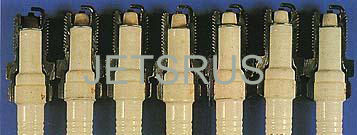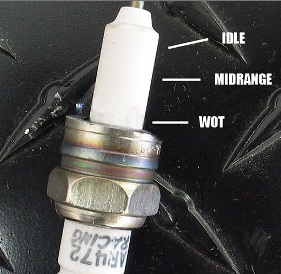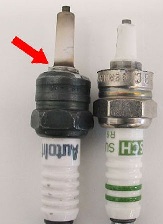| HOW TO READ SPARK PLUGS
How do I "read" the color of a spark plug? Look at the firing tip of your spark plug while paying close attention to the condition and color of the ceramic insulator and the metal electrode. Observe the color first. Light tan or gray deposits are normal, and an indication that everything is working well. If everything is very white with glazed deposits on the insulator tip, a too lean fuel mixture is likely (or the spark plug is too hot for the engine, or at least for the conditions for which it was used). If black sooty deposits are present, a too rich fuel mixture is likely ( or the spark plugs' heat range may be too cold for the application). Shiny black or oily deposits are an indication of bad oil seals and/or piston rings, and are not an indication that the spark plugs are at fault. Now I understand what the colors mean but how do I check the plug ? The following applies to ATV's streetbikes, dirtbikes etc. If you cannot perform this safely on a dyno, or at your local drag strip then take it to a shop. Use a fresh plug or one that has only a few passes on it. This works best in top gear or an upper gear on a slight uphill area. After running the engine at full throttle for about 8 to 10 seconds ( do not run up on the rev limiter as this will give a false reading of the plugs) do the following at the same time: pull in the clutch and stop the engine. DO NOT let the engine idle and DO NOT let the clutch out until the vehicle has come to a stop. Remove the spark plug and examine the INSULATOR (the porcelain) color. White is lean and black is rich. Best color is a tan to grayish-white. White means main jet is too small (lean) and black means main jet is too big (rich). Use common sense and don't do this if it is unsafe. The plug shown in the middle is the correct color The correct location to read the plug depends on what throttle range is being checked. Shown below, unleaded fuel leaves a light tan near the bottom of the insulator to indicate the A/F ratio. Unleaded fuel and ethanol fuels like E85 make reading plugs a bit more difficult because they burn cleaner and leave fewer deposits on the plug. Confirming readings with a wide-band oxygen sensor and/or quarter mile times is a good idea. |
|
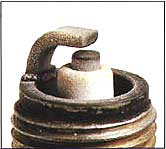 |
Normal Condition An engine's condition can be judged by the appearance of the spark plug's firing end. If the firing end of a spark plug is brown or light gray, the condition can be judged to be good and the spark plug is functioning optimally. |
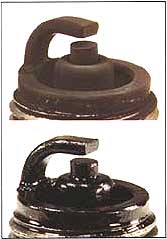 |
Dry and Wet Fouling Although there are many different cases, if the insulation resistance between the center electrode and the shell is over 10 ohms, the engine can be started normally. If the insulation resistance drops to 0 ohms, the firing end is fouled by either wet or dry carbon. |
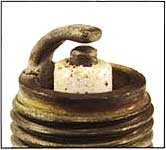 |
Overheating When a spark plug overheats, deposits that have accumulated on the insulator tip melt and give the insulator tip a glazed or glossy appearance. |
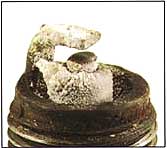 |
Deposits The accumulation of deposits on the firing end is influenced by oil leakage, fuel quality and the engine's operating duration. |
 |
Lead Fouling Lead fouling usually appears as yellowish brown deposits on the insulator nose. This can not be detected by a resitsance tester at room temperature. Lead compounds combine at different temperatures. Those formed at 370-470°C (700-790°F) having the greatest influence on lead resistance. |
 |
Breakage Breakage is usually caused by thermal expansion and thermal shock due to sudden heating or cooling. |
 |
Normal Life A worn spark plug not only wastes fuel but also strains the whole ignition system because the expanded gap (due to erosion) requires higher voltages. Normal rates of gap growth are as follows: Four Stroke Engines: 0.01~0.02 mm/1,000 km (0.00063~0.000126 inches/1,000 miles) Two Stroke Engines: 0.02~0.04 mm/1,000 km (0.000126~0.00252 inches/1,000 miles) |
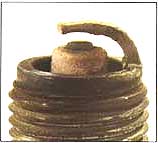 |
Abnormal Erosion Abnormal electrode erosion is caused by the effects of corrosion, oxidation and reaction with lead - all resulting in abnormal gap growth. |
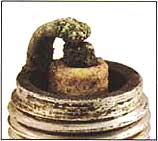 |
Melting Melting is caused by overheating. Mostly, the electrode surface is rather lustrous and uneven. The melting point of nickel alloy is 1,200~1,300°C (2,200~2,400°F). |
 |
Erosion, Corrosion and Oxidation The material of the electrodes has oxidized, and when the oxidation is heavy it will be green on the surface. The surface of the electrodes are also fretted and rough. |
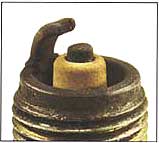 |
Lead Erosion Lead erosion is caused by lead compounds in the gasoline which react chemically with the material of the electrodes (nickel alloy) as high temperatures; crystal of nickel alloy fall off because of the lead compounds permeating and seperating the grain boundary of the nickel alloy. Typical lead erosion causes the surface of the ground electrode to become thinner, and the tip of the electrode looks as if it has been chipped. |
Q: How often should I replace my spark plugs? A: Unfortunately,there is no single answer to this question. As spark plugs grow older, they lose their sharp edges as material from the center and ground electrodes is slowly eroded away. As the gap between these two points grows, the voltage required to bridge the gap increases proportionately. Even the best ignition systems will be strained to supply enough voltage to completely burn the fuel. It is at this point, when fuel is being left unburned, that the time has come to change spark plugs. Replacing worn out spark plugs with new ones (with sharp new edges) effectively restores the ignition system's efficiency. Misfires are reduced, power is restored, economy of operation is enhanced and emissions are reduced. |
|
Q: What is a "fouled" spark plug? A: A spark plug is considered fouled when the insulator nose at the firing tip becomes coated with a foreign substance such as fuel, oil or carbon. This coating makes it easier for the voltage to follow along the insulator nose, leach back down into the metal shell and ground out rather than bridging the gap and firing normally. Many factors can contribute to spark plug fouling. The air/fuel ratio may be too rich as a result of incorrect carburetor adjustment or a poorly performing fuel injection system. Worn piston rings or valve seals may allow too much oil to leak into the combustion chamber, leading to oil fouling. The ignition system may not be performing properly. Prolonged idling or continuous low-speed driving may keep the spark plug from reaching its optimum operating temperature. Using too cold a spark plug can lead to the same problem. Finally, a dirty air cleaner can create a too-rich condition which can lead to fouling. Fuel, oil and carbon fouling can all be the result of different causes but, once a spark plug is fouled, it will not provide adequate voltage to the firing tip and that cylinder will not fire properly. In many cases, the spark plug cannot be cleaned sufficiently to restore normal operation. Therefore, it is recommended that a plug be replaced once it is fouled. |
|
| Q: Do I need to set the "gap" when installing a new set of plugs? A: Maybe. A spark plug part number might fit hundreds of different engines from many different manufacturers. Although the NGK factory will set the gap to a pre-selected setting, this may not be the right gap for your particular engine. The incorrect plug gap for your engine can contribute to a high rate of misfires, loss of power, plug fouling, poor fuel economy, and accelerated plug wear. It is always best to check the gap against the manufacturer's specifications. If adjusting the gap on fine wire or precious metal plugs such as platinum or iridium be very careful not to apply any pressure or prying force to the fine wire center electrode or insulator as they can be damaged. The gap should be adjusted by only moving the ground electrode. Another consideration that should be taken into account is the extent of any modifications that you may have made to the engine. As an example, when you raise compression or add forced induction (a turbo system, nitrous or supercharger kit) you must reduce the gap (about .004" for every 50 hp you add). However, when you add a high power ignition system (such as those offered by MSD, Crane, Nology) you can open the gap from .002-.005". |
|
Q: Why are there different heat ranges? A: It is a common misconception that spark plugs create heat. They don't. A heat range refers to how much heat a spark plug is capable of removing from the combustion chamber. |
|
Q: Does humidity affect spark plug temperature? A: Yes, humidity does affect spark plug temperature. As the humidity increases, the intake air mass decreases. This results in lower combustion pressures and temperatures, causing a decrease in the spark plug's temperature. |
|
Q: Does compression ratio affect firing end temperature? A: Yes, the by-product of increased compression is the elevation in cylinder temperatures. This is why it is recommended to choose a spark plug suitable for your application. NGK Spark Plugs recommends dropping heat ranges and altering Air/Fuel mixtures and timing as needed. It is very important to dissipate the excess heat from the combustion chamber in order to prevent pre-ignition. |
|
Q: What is the maximum I can open or close the gap? A: NGK doesn't recommend adjusting the spark plug gap more or less than .008". The reason for this is the ground electrode and center electrode won't line up properly, hindering spark plug performance. |
|
|
|
|
|
Home |
|
|---|
